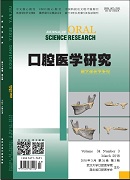|
|
Diagnosis, Treatment, and Image Analysis of Condylar Osteochondroma.
LING Bin, WANG Bin, SHAO Bo, GONG Zhong-cheng
2018, 34(3):
302-306.
DOI: 10.13701/j.cnki.kqyxyj.2018.03.022
Objective: To present a retrospective analysis of 6 cases of osteochondroma of the mandibular condyle (operated between 2010 and 2017) with respect to age, gender, site of the pathology, treatment modality, and recurrence. Methods: Medical records of X-ray, computed tomography, or MRI scans of all histologically proven osteochondroma of mandibular condyle cases operated between 2010 and 2017 were retrieved and examined. The data were tabulated and analyzed. Results: There were 1 males and 5 females, with a right:left ratio of 2.3:1. Age range was 34 to 68 years with a mean of 54.6 years. Four of 6 were superomedial in location. Five patients were treated by conservative condylectomy, whereas 1 required total condylectomy. In all cases, a preauricular with extended temporal approach was used. In the follow-up period ranging from 1 year to 7 years, there was no recurrence. Conclusion: Gradual facial asymmetry over the years is the most striking feature. Both the conservative condylectomy and the total condylectomy are curative. If the tumors grow superior or superomedial to condyle without causing much deflection of mandible, only excision and automatic swing back of condyle to correct asymmetry is required. But if causing much deflection of mandible, gnathic correction after excision of tumor is required.
References |
Related Articles |
Metrics
|

